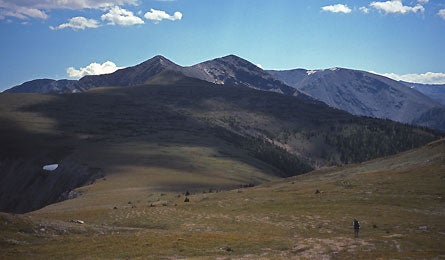Hike Montana's Anaconda-Pintler Wilderness

'Kurt Peak and Queener Mountain, Scott Bischke'
This winter, while everybody else is scouring maps and tracklogs for next summer’s big Glacier or Yellowstone trip, dig a little deeper into the Montana backcountry and discover the Anaconda-Pintler Wilderness–and the classic section of the Continental Divide Trail (CDT) that runs through it. Even locals tend to overlook this area–not for lack of grandeur, but because Montana’s premier parks are such draws. Translation: Anaconda-Pintler is like a private reserve for the few hikers who see it each year.
The 158,656-acre wilderness, tucked in the southwestern corner of the state, is named for the Anaconda Range, which has peaks as pointy as the Tetons and U-shaped valleys as wide as Glacier’s. The Pintler comes from Charles Pintler, a mountain man who settled the Big Hole Valley in the 1800s. About 65 miles of the CDT traverse the backbone of the wilderness, and the sweetest long-weekend-size chunk is the 34.6 miles from the Storm Lake trailhead south to the Pintler Creek trailhead–the majority of which are right on the CDT.
From the Storm Lake trailhead, switchback to 9,150-foot Storm Lake Pass, where wind and snow can howl anytime of year. From this point on, there are a bunch of peaks within bagging distance of the trail, but you’ll need more than a weekend to hit even a few of them. Three and a half miles in, your trail meets the CDT: Turn west, and drop through larch groves for another 1.7 miles. You’ll land in a campsite-perfect meadow near Page and Flower Lakes; at 8,400 feet, the water could still be frozen into July.
Don’t be fooled by the mellow first day. After about 2.5 miles on day two, the trail climbs 600 feet to Rainbow Pass. The 9,200-foot saddle is one of your weekend high points–along with the summit of 9,643-foot Rainbow Mountain (a half-mile scramble from the pass), where you’ll get 360-degree views of the Anacondas that few people ever see. From the pass, descend the Rock Creek drainage across talus and boulder fields into Queener Basin and climb back to the Divide at Cutaway Pass (mile 13.7). Then, essentially, do it again: Drop down to the toughest hump of the day–a lung-busting headwall climb to Warren Lake. If you have the time, lay over an extra day at Warren Lake and climb West Goat Peak, the highest point in the range at 10,793 feet. The best route, a 1.6-mile, 2,400-foot walk-up with some serious scrambling near the top, follows a ridge just east of the lakeshore. The view from the summit spans the Anaconda-Pintlers, the Big Hole Valley, and Yellowstone to the southeast.
On your final day, climb yet two more passes named Rainbow and Pintler (exhibits A and B in uninspired naming), losing and gaining elevation in 1,000- to 2,000-foot gulps. Bypass Oreamnos Lake, the most heavily used spot on the route, and tromp down the eight-mile descent to the Pintler Creek trailhead. Now you’re ready: Raise a glass to your own private wilderness preserve.
The Way
From Anaconda, take MT 1 west 15 miles. Turn left/south on FS 675 and follow it another 15 miles to the Storm Lake trailhead (the last mile or two may require 4WD). To reach the Pintler Creek trailhead, follow MT 43 off of I-15 (south of Butte) to the well-maintained FS 185.
Season
The high country is generally free of snow by mid-July, and the hiking stays good through mid-September.
Map
Anaconda-Pintler Wilderness Map; montanamaps.com/wil.pintlar.asp, $8
Contact
Beaverhead-Deerlodge National Forest: Wise River Ranger District, (406) 832-3178; Pintler Ranger District, (406) 859-3211; fs.fed.us/rl/bdnf for both
Permit
None required.